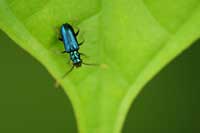Homo sapiens – an endangered species? Understand article
This year has been proclaimed the International Year of Biodiversity. During 2010, governments will seek to reach agreement on a new biodiversity target, to be decided at the Nagoya summit in October. Will this enable us to save not only whales and tigers, but also our own species? Marlene Rau…
Climate change, oil shortages, economy crisis, population growth, natural disasters, loss of biodiversity – we are facing an uncertain future, and so far, we do not seem to be doing a great job in meeting the challenge. The world’s leaders failed to agree on how to limit climate change at the UN Climate Change Conference in Copenhagen, Denmark, in December 2009. Next on the list is biodiversity, with the 10th meeting of the Convention on Biological Diversity (CBD) scheduled for October 2010 in Nagoya, Japan. But frankly, that is not looking good either.

What is the CBD?
In 1992, the largest ever meeting of world leaders took place at the UN Earth Summit in Rio de Janeiro, Brazil. This is where the CBD saw the light of day. It gained rapid and widespread acceptance: 168 countries signed the Convention in Rio, a further 26 countries signed later, and all but the USA have ratified it. With a total of 193 member states, it has near-universal participation. Importantly, the CBD is legally binding; countries that join and ratify it have committed themselves to implement its provisions. However, no sanctions are in place in cases where a country does not comply with the agreed rules.
The idea behind the CBD

The CBD covers all ecosystems, species and genetic resources. Contrary to previous, more rigorous, conservation efforts, the CBD recognises that ecosystems, species and genes will and should be used for the benefit of humans, if only in a sustainable way, at a rate that does not lead to the long-term decline of biological diversity.
An essential part of the biodiversity debate involves the commercial use of genetic material. Most of the world’s biodiversity is found in developing countries. Historically, however, bioprospectors from the developed world have collected micro-organisms, plants or animals to develop new commercial products, such as drugs, often without fair benefits to the source country. The CBD recognises national sovereignty over all such genetic resources, so the country of origin will receive its fair share in the form of money, samples or training of national researchers.
The CBD also covers the rapidly expanding field of biotechnology, specifically with the Cartagena Protocol on Biosafety, a supplementary agreement adopted in January 2000, which seeks to protect biodiversity from the potential risks posed by genetically modified organisms. Although most of Europe has joined, a total of 39 of the CBD member states, including Australia, Canada, Iceland, Israel, Liechtenstein, the Russian Federation and the USA, have not ratified the Cartagena Protocol.
How does the CBD work?
As an international treaty, the CBD identifies a common problem; sets overall goals, policies and general obligations; and organises technical and financial co-operation. But the responsibility for achieving its goals rests largely with the countries themselves, and it is up to the national governments to implement changes. Individual countries need to find effective incentives for their landowners, fishermen, farmers and private companies to adhere to the treaty, and to inform the public. Ultimately, however, their success is our own responsibility – by carefully choosing the products we buy and the government policies that we support, we can begin to steer the world towards sustainable development.
“Sustainability is no longer just a moral issue; it is also becoming an issue of self-interest. It is not just about how we will leave our planet to future generations, but also about ensuring there are sufficient resources for our own generation.”
EU Environment Commissioner Janez Poto?nik
The CBD’s definitive authority is the Conference of the Parties (COP), consisting of all governments that have ratified the treaty. The COP reviews progress, identifies new priorities, and sets work plans for the members. It is the COP that will meet in Japan in October 2010.
Progress and the problems faced

/ iStockphoto
After a surge of interest in the wake of the Rio Summit in 1992, progress has been disappointingly slow. Attention to environmental problems was distracted by a series of economic crises, budget deficits, and local and regional conflicts. Despite the promises made in the CBD, drafted in Rio, little has been done to curb the environmental effects of economic growth. The biggest hurdle for sustainable development decisions is the conflict between short- and long-term benefits: it still pays to exploit the environment by harvesting as much as possible as quickly as possible, because the rules of a free market economy do little to protect long-term interests.
Another fundamental challenge for the CBD lies in the broad scope of its objectives: getting all sectors of the national economy, society and the government to work together is a complex task. This would require co-operation between many different actors, such as regional bodies and organisations. And, remember – countries that do not meet the set goals do not actually face any sanctions.
In 2002, 10 years after the CBD was opened for signature, its success was not exactly overwhelming: national action plans had been developed in more than 100 of the 193 member countries, but the loss of biodiversity was accelerating. As a result, the member states committed themselves to a significant reduction of the rate of biodiversity loss by 2010.
However, the COP admitted that this was rather theoretical: “Unprecedented additional efforts would be needed to achieve, by 2010, a significant reduction in the rate of biodiversity loss at all levels… Most of the direct drivers of biodiversity loss are projected to either remain constant or to increase in the near future. Moreover, inertia in natural and human institutional systems results in time lags – of years, decades, or even centuries – between actions being taken and their impact on biodiversity and ecosystems becoming apparent.”

/ iStockphoto
So what is the situation in the run-up to the 2010 meeting? Has the challenge been met after all? Unsurprisingly, the answer is no. The world is still losing biodiversity at an ever-increasing, hence unprecedented, rate. There are at least some partial or regional successes to be reported, however: they include a slowing in the rate of Brazilian Amazonian deforestation by 74% (although an area about the size of Northern Ireland is lost there every year; worldwide, an area the size of Costa Rica is deforested each year) and a reduction of 45% in the annual rate of mangrove losses (but still, about 6% of the global mangrove areas are lost per year). The number of Important Bird Areas (IBAs)w1 has approximately doubled since 2002; these now cover between 5 and 8% of each continent except Antarctica, although not all IBAs are protected. More than 12% of terrestrial areas are now under some form of protection.
The task for the Nagoya summit will be to prepare, adopt and implement a new strategic plan for 2011-2020, including a ‘2050 biodiversity vision’. The idea is to improve the previous plan: more realistic goals, based on scientific results and with better logistic support.
So, let’s hope that the world takes Ahmed Djoghlaf, Executive Secretary of the CBD, seriously, who admonishes: “As Charles Darwin stated, ‘It is not the strongest of the species that survives, nor the most intelligent… It is the one that is most adaptable to change.’ This is valid not only for human beings but also for institutions and processes. The world has changed, and the global partnership for biodiversity will need to adapt to these changes… As Darwin also said, ‘In the long history of humankind…those who learned to collaborate and improvise most effectively have prevailed.’”
Why is biodiversity important?
The biodiversity we see today is the result of billions of years of evolution, shaped by natural processes and, increasingly, by the influence of humans. As of 18 April 2010, the human population was estimated to be about 6.8 billion, and was predicted to reach 9 billion by 2050, according to UN experts. Our demands on the world’s natural resources grow even faster than that: whereas the population has more than doubled since 1950, the global economy has quintupled, with most of this economic growth occurring in relatively few industrialised countries.
For many, nature seems remote from their everyday lives – food is associated with shops, rather than with its natural source. Yet biological resources are the basis of our existence: they support such diverse industries as agriculture, cosmetics, pharmaceuticals, pulp and paper, horticulture, construction and waste treatment.
The ability of ecosystems to deal with natural disasters, as well as with pressures caused by humans such as pollution and climate change, is weakened. Loss of biodiversity also means reduced productivity of ecosystems. Food is one of these products, and its supply is facing serious disruption: for thousands of years, we have been developing a vast array of domesticated plants and animals. However, modern commercial agriculture focuses on relatively few crop varieties, and about 30% of breeds of the main farm animal species are currently at high risk of extinction. For example, an astonishing 90% of cattle in industrialised countries come from only six very tightly defined breeds. Maintaining animal genetic diversity would be essential to allow future generations to select stocks or develop new breeds to cope with emerging issues, such as climate change, diseases and changing socio-economic factors.
Although loss of species has always occurred naturally, human activity has dramatically accelerated this loss: we are creating the greatest extinction crisis since the natural disaster that wiped out the dinosaurs 65 million years ago. These extinctions are irreversible and, given our dependence on food crops, medicines and other biological resources, pose a threat to our own survival.
Web References
- w1 – To find out more about Important Bird Areas, see: www.birdlife.org/action/science/sites
Resources
- For complete information on the Convention on Biological Diversity, including all national profiles, see: www.cbd.int
- The CBD runs a biodiversity website for children, including games, a glossary and an educator’s corner: http://kids.cbd.int
- The European Commission has launched a biodiversity campaign, ‘We are all in this together’, to show the real implications that biodiversity loss will have on our daily lives, and to promote actions that people can take to protect nature. It is available in many European languages. See: http://ec.europa.eu/environment/biodiversity/campaign
- For a review of the most inspiring discoveries in the field of biodiversity that were made in 2009, see:Kaplan M (2010) Biodiversity: a look back at 2009. Science in School 14: 28-31. www.scienceinschool.org/2010/issue14/biodiversity
Review
Biodiversity is being destroyed at an alarming rate, yet somehow, many individuals are still unaware of the threats we are facing due to this loss. What are the authorities doing and what are we doing? Are there any actions we should be taking? Is it really true that we are destroying our planet?
This topical article can be used in biology and chemistry classes, especially when teaching ecology and environmental science topics.
Possible comprehension questions and points for discussion include:
- What do you understand by the term ‘sustainable development’?
- What is biodiversity?
- List three major crises the world is currently facing.
- What is a convention, and what grounds are usually laid during a convention of this kind?
- Mention three objectives of the CBD.
- Which stages does the CBD go through to tackle environmental problems?
- What is your opinion about how the CBD handles environmental problems? Is any good coming from this convention?
- Discuss how the loss of biodiversity impacts our lives.
Andrew Galea, Malta





